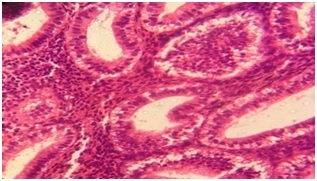Histopathological evaluation of endometrial biopsies and curetting’s in abnormal uterine bleeding
Abstract
Introduction: Abnormal uterine bleeding (AUB) is the most common complaint in the gynecology out-patient department with different presentations and varied causes. Endometrial sampling is needed to investigate the cause of AUB.
Aim: This study was done to evaluate histopathology of endometrium and observe the incidence of various endometrial pathology patterns in different age groups presenting with abnormal uterine bleeding.
Materials and Methods: The current study was done at Malla Reddy Medical College for Women, Hyderabad, India, on cases of abnormal uterine bleeding who underwent endometrial sampling. A statistical analysis between age of presentation and specific endometrial causes was done using χ2 test.
Results: We studied231 cases. The most common pattern observed was normal cycling endometrium (56.27%). The other morphological patterns were endometrial hyperplasia (19.48%), disordered proliferative pattern (5.62%), complications of pregnancy (4.76%), benign endometrial polyp (2.6%), chronic endometritis (2.16%) and carcinoma (0.86%). The most common age group presenting with AUB was 40-49 years (47.18 %) followed by 30-39years (33.76%). Endometrial causes of AUB and age distribution was statistically significant with P value<0.05.
Conclusion: There is an age specific association of endometrial lesions. Atrophy and carcinoma endometrium are predominant in peri-menopausal and post-menopausal age. Endometrial curettings and biopsy proved to be an important diagnostic procedure for assessment and subsequent management of abnormal uterine bleeding.
Downloads
References
2. Albers JR, Hull SK, Wesley RM. Abnormal uterine bleeding. Am Fam Physician. 2004 Apr 15;69(8):1915-26.[pubmed]
3. MunroMG, Critchley HOD, Broder MS, Fraser IS. FIGO classification system (PALM-COIEN) for causes of abnormal uterine bleeding in nongravid women of reproductive age. Int J GynecolObstet 2011;113(1):3-13.doi:10.1016/j.ijgo.2010.11.011.[pubmed]
4. Khan R, Sherwani RK, Rana S, Hakim S, Jairajpuri ZS. Clinico-Pathological Patterns in Women with Dysfunctional Uterine Bleeding. Iran J Pathol 2016; 11(1): 20-26.[pubmed]
5. McCluggage WG. My approach to the interpretation of endometrial biopsies and curettings. J Clin Pathol. 2006 Aug;59(8):801-12.[pubmed]
6. SajithaK,Padma SK, Shetty KJ, Kishan Prasad HL, Permi HS, Hegde P. Study of histopathological patterns of endometrium in abnormal uterine bleeding. CHRISMED J Health Res 2014;1(2):76-81.doi:10.4103/2348-3334.134265.
7. Vaidya S, Lakhey M, Vaidya S, et al. Histopathological pattern of abnormal uterine bleeding in endometrial biopsies. Nepal Med Coll J. 2013 Mar;15(1):74-7.[pubmed]
8. Doraiswami S, Johnson T, Rao S, et al. Study of endometrial pathology in abnormal uterine bleeding. J ObstetGynaecol India. 2011 Aug;61(4):426-30. doi: 10.1007/s13224-011-0047-2. Epub 2011 Sep 22.
9. Devi LS, Singh MR, Singh LR, Debnath K. The histological and histochemical study of endometrium in dysfunctional uterine bleeding. J Med Soc 2012;26(3):167-70.doi: 10.4103/0972-4958.113240.
10. Longacre TA, Atkins KA, Kempson RL, Hendrickson MR. The Uterine Corpus. In: Mills S editor. Sternberg’s Diagnostic Surgical Pathology. 5th ed. Philadelphia: Lippincott Williams & Wilkins;2010.
11. Shah RJ, Dayal A, Kothari SL, Patel SM, Dalal B. Histopathological interpretation ofendometrium in abnormal uterine bleeding. Int J Med Sci Public Health 2014;3(4):452-456. doi:10.5455/ijmsph.2014.12022
12. Parra-HerranC.Endometrial hyperplasia – general. PathologyOutlines.com website.http://www.pathologyoutlines.com/topic/uterusendometrialhyperplasiageneral.html.Accessed March 27th, 2019.
13. Divya KN, Jayashree K, Bharath C. The Diagnostic Value of Endometrial Biopsy in Postmenopausal Uterine Bleeding. Indian Journal of Pathology: Research and Practice 2017;6(1):45-51. doi:http://dx.doi.org/10.21088/ijprp.2278.148X.6117.7
14. Desai K, Patole KP, Kathaley M. Endometrial Evaluation by Histopathology in Abnormal Uterine Bleeding in Perimenopausal and Postmenopausal Patients. MVP Journal of Medical Sciences 2014 Jul;1(2):75-79.
15. HileetoD,Fadare O, Martel M, Zheng W. Age dependent association of endometrial polyps with increased risk of cancer involvement. World J Surg Oncol. 2005;3:8. doi:10.1186/1477-7819-3-8.



 OAI - Open Archives Initiative
OAI - Open Archives Initiative


